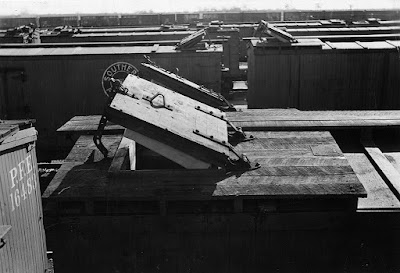In 1935, Pacific Fruit Express, lacking funds to entirely rebuild its many older cars, began a program that they called “reconditioning.” (There is considerable information available beyond the brief summary presented in this post; see Chapter 7 in Pacific Fruit Express, 2nd edition, Signature Press, 2000). This meant replacing damaged or worn parts in kind, particularly wood superstructure framing, but not modernizing, other than ladders in place of grab iron rows, and modern hand brakes.
The first car of this program, PFE 91022, was built as a test car and completed in June 1936. It would be the first of more than 7500 cars that went through this program, nearly all classed as R-30-9. It’s shown below at Roseville (PFE photo, CSRM). Note in particular the wood ice hatch covers, wood ice hatch platforms, and hatch plugs below the the covers.
For a better view of this ice hatch arrangement, the photo below (PFE photo, CSRM) shows a hatch platform and a hatch cover open as far as it can go (at the top of the latch bar). The separately-hinged hatch plug is beneath the cover. Note the hatch rest in the center of the hatch cover, and the small metal striker plate at right on the hatch platform, where the hatch rest strikes if covers are entirely open for icing.
But before long, based on experience with roofs of steel cars, PFE decided to dispense with ice hatch platforms, relying instead on slate granules in the roof paint to provide adequate footing for workmen doing icing. But a wood bar was retained on the roof to put the hatch rest striking plate at the correct height. This photo shows the roof of Class R-30-9 car 92508. This is a car reconditioned in 1937 from a 1923-built car of Class R-30-12, 25756. The photo was taken at Gering, Nebraska in 1957 (Virl W. Davis photo). Note also that the hatch covers clearly sit higher than the roof.
A side view may be more clear. Below is a detail of a PFE photo during icing (my collection), and on both cars you can see the raised hatch coaming and the hatch striker bars. Note also the open hatch plugs atop each hatch cover. The plywood-sheathed car at right is PFE 94242, one of a small number of Class R-30-9 cars to get such sheathing.
These details apply only to the earlier cars in Class R-30-9, because in 1938 PFE decided to replace wood ice hatch covers and plugs with one-piece steel ice hatches, as were applied to steel PFE cars. In Class R-30-9, this meant that PFE 95737 and higher numbers had these integral steel hatches.
The impact of these details on modeling PFE’s Class R-30-9 is that the very nice Red Caboose HO scale kit for Class R-30-9 offers the chance to model either the wood hatch covers with an ice hatch platform, or a steel hatch without platform. You can even model the wood covers without a platform, but that leads to a difficulty, visible in the prototype photos above. The wood ice hatch cover sits above the roof, as it should, but there is no support for its hinges, nor is there any ice hatch striker bar; those would be part of the platform.
Of course, these are easily added with styrene. Below is the roof of a kit I am working on, with the additions of striker bars and hinge supports fairly obvious. It will, of course, be the roof of a car numbered below PFE 95737, and will end up looking like the above photo of the roof of PFE 92508.
I will say more about this kit in a future post.
Tony Thompson





No comments:
Post a Comment